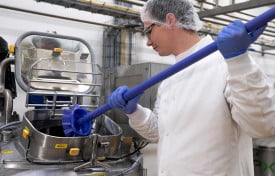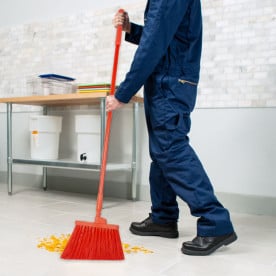Sanitation & Janitorial

- June 03, 2020
The COVID-19 pandemic disrupted normal operations for countless food and beverage manufacturers. Disruptions from future pandemics may occur due to limited staff because of layoffs, social distancing requirements, or sickness; additional sanitation requirements to control viral transmission; changes in production levels; and possibly plant shutdown. These situations can lead to the need of resources for food safety sanitation.
It is essential that food manufacturers create safe, quality food, therefore, routine practices need to continue and additional sanitation may need to be added. Employers also need to ensure a safe environment for their staff, including minimizing the risk of being exposed to harmful viruses and infections.
- February 12, 2020
Cleaning and sanitizing, though often used interchangeably, play distinct and crucial roles in ensuring the safe production of high-quality dairy products, food, and beverages. Cleaning involves physically removing visible dirt, grease, and particles from surfaces, making them shiny and spotless. However, it doesn't eliminate illness-causing pathogens. On the other hand, sanitizing, which follows cleaning, reduces harmful microorganisms to safe levels. Skipping the cleaning step renders sanitizing ineffective. The process includes wetting, scrubbing, rinsing, applying sanitizer, and allowing the surface to air dry. Both actions are vital to prevent pest infestations, comply with food safety laws, protect against foodborne illnesses, and minimize waste. Training is crucial, ensuring employees understand the proper use of chemicals, concentration, mixing procedures, storage, and the importance of personal protective equipment. Color-coding tools helps prevent cross-contamination, emphasizing
- January 02, 2020
What's a MERV...?
Minimum Efficiency Reporting Value (MERV) is the established air filter industry rating that measures the effectiveness of air filters based on the ASHRAE rating. The higher the MERV rating, the finer the filtration, meaning fewer dust particles and other airborne contaminants that can pass through the filter.
For example, a MERV-13 filter has to catch 90% of particles in the 1-10 µm ranges and 75% of particles in the .3-1 µm range.
Understanding Microns
A single strand of the finest human hair is approximately 20 micrometers, or microns, in diameter. If you would slice that strand in half and then slice one
of those halves in half...and then one more time, you are left with a strand that is 2.5 microns in diameter. As you can see in the chart below, there are three different ratings depending on the micron size and as you learned above, those particles are extremely tiny. The - May 01, 2019
Nelson-Jameson has expanded their color-coded program once again with the release of their 2019 Color-Coded Catalog. This year's catalog has grown to 56 pages of products that help to prevent allergen migration and cross-contamination. From the lab to the processing line, Nelson-Jameson has the color-coded products you need to produce safe, quality food.
In addition to having the most extensive color-coded program in the industry, we also have the most color options! Nelson-Jameson is now proud to offer gray, brown and lime products from Remco/Vikan® to help meet all your color-coded needs. The expanded catalog also includes new items like Color-Coded Cable Ties, Flagged Angle Brooms, Nylon Scrapers and more!
- August 08, 2018
Nelson-Jameson is proud to partner with Valcour Process Technologies to provide our customers with the equipment needed to inspect a wide assortment of product to prevent contamination. The Shield Allegro is a powerful X-ray inspection system that provides a higher level of inspection over traditional metal detectors.
While metal detectors provide reliable and robust contaminant detection technology, X-ray inspection technology
helps to ensure improved product quality by providing these additional benefits:- Designed to inspect a wide assortment of packages up to 450 mm (17.7") wide and 254 mm (10") high. Products are typically inspected after packaging but can be inspected as raw product or packaged in a box.
- Detects smaller sizes of stainless steel (2-2.5 mm vs. 6-8 mm), as well as a variety of other contaminants that aren't possible with a metal detector.
- Easy to use, 17" touch screen display provides a digital trail of images for each product
- August 30, 2016
When I joined the lab team in May I was familiar with lab equipment and testing but I wasn’t familiar with luminometers and ATP. I had heard
- October 08, 2015
Navigating the world of lubricants in the food industry involves considering NSF ratings, a crucial aspect in ensuring compliance with safety standards. Understanding these ratings is essential for making informed choices in various applications. The H1 rating designates lubricants suitable for incidental food contact, allowing use in and around food processing areas. These lubricants can protect against rust, act as release agents, and serve as machine lubricants with minimal exposure to food. On the other hand, H2-rated lubricants are intended for areas with no potential contact with edible products. Meanwhile, the 3H rating applies to release agents or direct food contact, particularly on surfaces in contact with food during processing. Some lubricants can hold both H1 and 3H ratings, offering versatility. For detailed guidance on selecting the right lubricant for your application, our Lubricant Specialists are ready to assist you at 800-826-8302.







